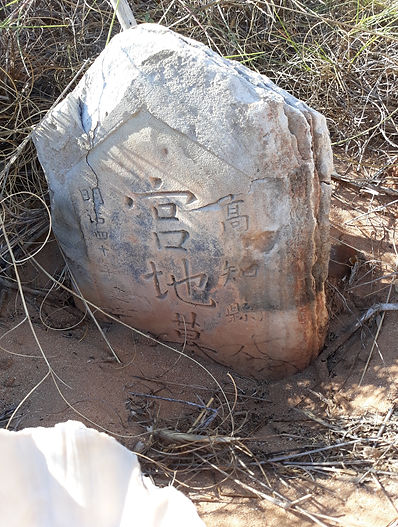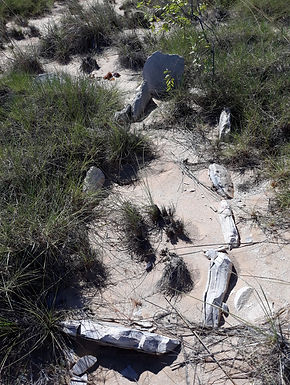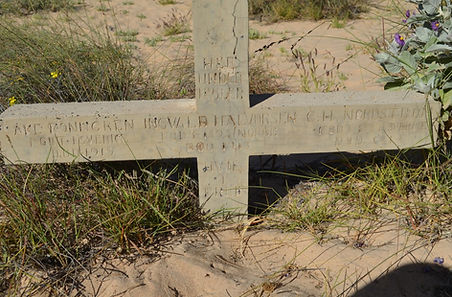
Lonely Sailors Graves in Northern Western Australia

Indonesian fishermen - Ashmore Reef

Just inside the Australian Economic Exclusion Zone only 70 miles south of Indonesia sits Ashmore Reef and West Island. For centuries Indonesian fisherman from Palau Roti have used the sheltered lagoons of Ashmore Reef for fishing grounds and safe anchorage. Located on West Island on the eastern shore near a solitary of palm tree is located the burial grounds for the traditional fisherman of Indonesia. A number of graves that are still marked surround the site and seem to be relatively modern. Although Ashmore Reef is recognised as Australian soil Indonesian fisherman are still permitted to visit Ashmore and it's surrounding ocean and Atolls if fishing by traditional means. They can also legally pass into Australian waters for safe anchorage and for visiting sites such as the graveyards or collecting water from the wells found on the islands and atolls.




Pearlers Graves - Buccaneer Archipelago



Alone and isolated on a remote beach in the Kimberley, near the entrance to a bay once called the "Divers' Graveyard" and now written on nautical charts as just the "Graveyards" lay the final resting places of these unknown pearlers.
The only clues to their identities are the remaining headstones of their marked graves, One headstone is marked as "diver" but it is unknown whether the others were divers or crew. Their nationality is also a mystery. Those that are marked with names seem to be Asiatic and have headstones featuring the Christian cross, the two headstones marked with dates span only two years from 1889 to 1891. All that is really known is that they died on one of the most remote and extreme coastlines on the planet far from their homelands.
The pearlers must have arrived in the far north in a time when the pearling industry was starting to boom. Broome was gazetted as a town in 1883 and soon came forth the many hundreds of pearling vessels equipped with the deep sea diving apparatus. This signaled the end of the use of Indigenous skin divers diving for shell with the horrendous atrocities associated with it. Workers of all nationalities arrived on the WA coast mostly from South East Asia including, Koepangers, Malays, Japanese, Manilamen and Chinese. With the new deep sea diving helmets and diving suits, the luggers were able to expand to deeper areas and further afield in search of fresh shelling grounds. Still there were hundreds of deaths associated with the divers and crews of the luggers, divers regularly died or were crippled by the bends, whole crews and luggers were lost to cyclones and many from foul play amongst crews of different nationalities.
It's unknown the stories of these 3 graves and possibly more unmarked graves on this beach. However, it is poignant to think these are only three of what must be hundreds of lonely and forgotten graves throughout the Kimberley Coast from a bygone era of death and fortune, they lay undisturbed and isolated, remote reminders of history that have stood for well over a century, still in the state they were left when they were laid to rest.


Pearlers Graves - King Sound


TRAGEDY AT SHENTON BLUFF: "A Malay shot another in the back with a shotgun and then stabbed himself to death"
Located up high in the dunes on the Dampier Peninsular at a place called Shenton Bluff, lays this rarely visited old pearlers cemetery.
Back at the turn of the 20th century from the late 1890's to the early 1920's, pearling luggers used to call in and camp near Shenton Bluff. It was a place of abundant fresh water from a spring that flowed from the dunes nearby and its location was the stepping stone across King Sound to the pearling grounds to the north that offered protection while collecting shell during the monsoon season. The pearling crews were notorious for vicious infighting amongst crews of differing national heritage and vastly outnumbered European men in a harsh and lawless place on what was then beyond the outskirts of civilisation.
Most of the graves are unmarked besides two, a Japanese grave, possibly a diver's and the grave of William J Easton who died aboard the Royal Navy surveying vessel the HMS Fantome while charting the entrance to King Sound in 1909. Of the other graves there are no identifying features however, the NLA database digs up some gruesome and chilling accounts of deaths that happened at Shenton Bluff amongst the clashing multicultural Asian crews on of the lugger fleets operating out of Cygnet Bay.
Monday 28 April 1902 p3 Geraldton Advertiser:
TRAGEDY AT SHENTON BLUFF: "A malay shot another in the back with a shotgun and then stabbed himself to death"
Thursday 7 Jan 1897 p3 Goldfields Cronicle
MURDER AT CYGNET BAY: "murder of a malay on Boxing Day, by Manilamen, who inflicted 6 knife wounds, and drove a crowbar through the body"



Whalers Grave - Dampier Archipelago

The lonely and heavily disturbed stone piles just above the high tide mark on Enderby Island are thought to be all that remain of three unknown and unmarked graves discovered in 1851 by Lieutenant F.B Helpman, one of the first surveyors to come ashore on the island while searching for guano deposits. It is unknown their origin but it's most likely to be the burial sites of a whaling crew that would have sailed these waters in the early 18th century.

American whalers were known to have hunted off the West Australian coast well before the settling of Albany and the Swan River Colony and as early as the 1780's. They'd often leave their homeports on the east coast of North America, leaving for months on end and travelling around the globe searching the most productive hunting grounds to produce whale oil to keep the gears of the industrial revolution moving. Often the whalers would never return to their home ports and were destined to be lost at sea or on distant shores, scattered around almost every shoreline on the planet, unknown to their families or history for eternity.

Whalers Grave - Norwegian Bay

In isolation 60 kilometres north of Coral Bay, lays a lonely cement headstone of 3 young North European sailors. Hidden and undisturbed on a remote sand dune on Ningaloo Station.
"Here below at rest - Ake Ronngren, born in Sweden, died
1915 - Ingvald Halvorsen, born 1893 in Norway, died 1913 - GH Nordstrom, born 1887 in Sweden, died 1914."
These young men lost their lives far from home, on the opposite side of the world from their families and loved ones and a century later still remain in a location of isolation at their rarely visited memorial. The three deaths occurred while the men worked for the West Australian Whaling Company that operated in the North West from 1912 to 1919. No detail is known of the death of Ingvald Halvorsen, but it was recorded the Ake Ronngren died of a concussion after a year on the West Australian coast and Gustaf Helmer Nordstrom, a Swedish sailor, drowned on 18th of July 1915.
The West Australian Whaling Company established the Norwegain Bay whaling station in 1915 and operated until the closure of their lease in 1919.
References: Coate, Yvonne & Kevin, More Lonely Graves of Western Australia, Hesperian Press, Perth, 2000, p.160.
Hertitage Council of Western Australia: Register of Heritage Places - Assess Doc’n Norwegian Bay Whaling Station (ruins) 22/08/2006

